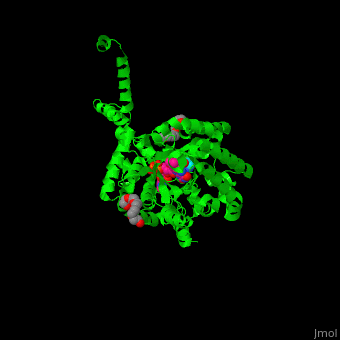Proline utilization A: Difference between revisions
Michal Harel (talk | contribs) No edit summary |
No edit summary |
||
| Line 4: | Line 4: | ||
== Structural highlights == | == Structural highlights == | ||
The <scene name='70/706260/Cv/ | The <scene name='70/706260/Cv/5'>active site residue Tyr540 helps in substrate preference for proline over hydroxyproline</scene>. Water molecules are shown as red spheres. The [[3e2q]] structure displayed here contains the <scene name='70/706260/Cv/6'>Tyr540Ser mutant</scene><ref>PMID:19140736</ref>. | ||
</StructureSection> | </StructureSection> | ||
Revision as of 16:16, 14 August 2019
FunctionProline utilization A (PutA) is a bifunctional flavoprotein which acts as a transcriptional repressor of the put regulon or as a membrane-bound enzyme which catalyzes the oxidation of proline to glutamate. PutA domains include the DNA-binding domain (PRODH), the FAD-dependent proline dehydrogenase domain and the D-pyrroline-5-carboxylate dehydrogenase domain. The binding of proline to the PRODH active site and subsequent reduction of FAD causes a conformation change in PutA and enhance its membrane affinity. As a membrane-bound protein PutA switches from its repressor activity to its enzymatic role[1]. Structural highlightsThe . Water molecules are shown as red spheres. The 3e2q structure displayed here contains the [2]. |
| ||||||||||
3D Structures of proline utilization A3D Structures of proline utilization A
Updated on 14-August-2019
ReferencesReferences
- ↑ Srivastava D, Zhu W, Johnson WH, Whitman CP, Becker DF, Tanner JJ. The Structure of the Proline Utilization A Proline Dehydrogenase Domain Inactivated by N-Propargylglycine Provides Insight into Conformational Changes Induced by Substrate Binding and Flavin Reduction (,). Biochemistry. 2009 Dec 29. PMID:19994913 doi:10.1021/bi901717s
- ↑ Ostrander EL, Larson JD, Schuermann JP, Tanner JJ. A Conserved Active Site Tyrosine Residue of Proline Dehydrogenase Helps Enforce the Preference for Proline over Hydroxyproline as the Substrate (dagger) (double dagger). Biochemistry. 2009 Feb 10;48(5):951-9. PMID:19140736 doi:10.1021/bi802094k
